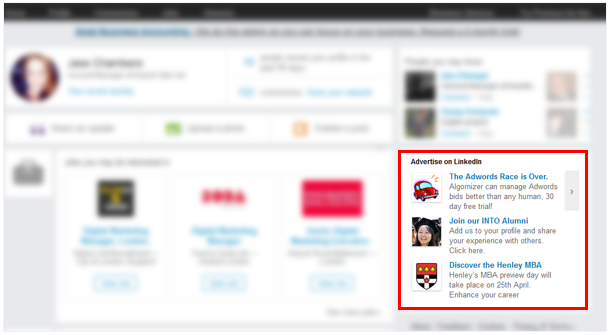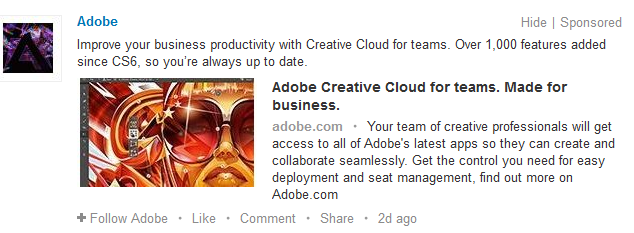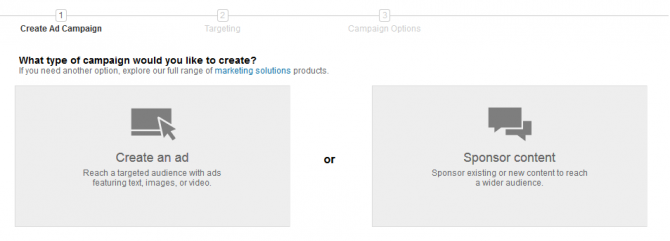LinkedIn members are professionals wanting to network with like-minded individuals, find a job or share work-related content. Despite having a much smaller audience than other social networks, ads can be targeted using details such as company names, job titles, industries, locations and seniority, to name but a few. LinkedIn has introduced new selection features recently such as Audience Expansion which shows ads to LinkedIn members that closely match your specified target audience which can help increase ad visibility.It’s a great tool for directing ads to people of a particular seniority, function industry or location. People generally keep their LinkedIn profiles more up-to-date than they do on Facebook, so if you have a specific job title or level of seniority in mind that you want to get your ads in front of then LinkedIn should be your platform of choice.Unlike pretty much every other social media advertising platform, LinkedIn has kept things basic in terms of its ad offering. There are text ads, display ads and sponsored posts.Text & Display AdsText and Display ads are the quickest and easiest way to start advertising on LinkedIn.Up to three ads will appear on the page at any time: Display ads contain a 50 x 50 pixel image which appear throughout the website on the side bar – great for attracting clicks. Video playback is a newer feature and square videos of up to 20 seconds in length that pop out when users click on them can be used.Ad copy is limited to 25 characters for a headline and should be as bold and engaging as possible. Once you’ve caught their attention, there are a further 75 characters with which to sell your product, service or idea. We recommend you include a call to action such as Request a Demo, Try It Today or Book Now to encourage people to click through to your landing page.We also recommend refreshing the ad copy at least once a month. LinkedIn Ads are more prone to ‘ad fatigue’ than other platforms as they are shown to a highly specific and often limited audience. Without refresh, CTRs are likely to decline rapidly. Within LinkedIn you can also create multiple ads per campaign so you can test them against each other with different calls to action or images to understand which ads fare better.It is important to note that there is no conversion tracking through LinkedIn so remember to tag all URLs with tracking parameters to ensure the data is recorded in Analytics and labelled as LinkedIn / cpc. This will allow you to measure the effectiveness of your adverts and calculate ROI. The reporting interface in LinkedIn is basic to say the least!Sponsored PostsVisible in the home news feed, sponsored posts are often what members see first when they log into LinkedIn. It is a priority position - people are scrolling through and scanning the headlines to catch up on what they have missed. Sponsored posts are a great option if you’re looking to increase page followers or engagement, as well as announce new products and offers.
Display ads contain a 50 x 50 pixel image which appear throughout the website on the side bar – great for attracting clicks. Video playback is a newer feature and square videos of up to 20 seconds in length that pop out when users click on them can be used.Ad copy is limited to 25 characters for a headline and should be as bold and engaging as possible. Once you’ve caught their attention, there are a further 75 characters with which to sell your product, service or idea. We recommend you include a call to action such as Request a Demo, Try It Today or Book Now to encourage people to click through to your landing page.We also recommend refreshing the ad copy at least once a month. LinkedIn Ads are more prone to ‘ad fatigue’ than other platforms as they are shown to a highly specific and often limited audience. Without refresh, CTRs are likely to decline rapidly. Within LinkedIn you can also create multiple ads per campaign so you can test them against each other with different calls to action or images to understand which ads fare better.It is important to note that there is no conversion tracking through LinkedIn so remember to tag all URLs with tracking parameters to ensure the data is recorded in Analytics and labelled as LinkedIn / cpc. This will allow you to measure the effectiveness of your adverts and calculate ROI. The reporting interface in LinkedIn is basic to say the least!Sponsored PostsVisible in the home news feed, sponsored posts are often what members see first when they log into LinkedIn. It is a priority position - people are scrolling through and scanning the headlines to catch up on what they have missed. Sponsored posts are a great option if you’re looking to increase page followers or engagement, as well as announce new products and offers. Once you’ve posted a normal update on your company page, you have the option to pay to boost the post to a larger audience on the LinkedIn network with the posts appearing directly in their news stream which helps to increase engagement with the post.To sponsor a post, select the post you want through the advertising platform’s Create New Campaign button, and as with text and display ads, choose an audience to target. Remember that each piece of content is likely to appeal to different groups so make sure you chose the right audience to maximise the post’s potential.Next, set a bid for the sponsored content – either CPC or CPM – and you’re ready to go! Clicks are fairly expensive compared to other platforms, so don’t be surprised if your CPC is much higher than on other paid media. The minimum bid is £1.50 in the UK and $2.00 in the US.While still a basic platform for advertising there are other options available to drive business, contacts and leads:
Once you’ve posted a normal update on your company page, you have the option to pay to boost the post to a larger audience on the LinkedIn network with the posts appearing directly in their news stream which helps to increase engagement with the post.To sponsor a post, select the post you want through the advertising platform’s Create New Campaign button, and as with text and display ads, choose an audience to target. Remember that each piece of content is likely to appeal to different groups so make sure you chose the right audience to maximise the post’s potential.Next, set a bid for the sponsored content – either CPC or CPM – and you’re ready to go! Clicks are fairly expensive compared to other platforms, so don’t be surprised if your CPC is much higher than on other paid media. The minimum bid is £1.50 in the UK and $2.00 in the US.While still a basic platform for advertising there are other options available to drive business, contacts and leads:  Premium Display Ads – audience targeted, display advertising in premium placements available as for ads of the following sizes: 300 x 250,160 x 600, 728 x 90 as well as a text link ad that appears at the top of the page without an image.Sponsored InMail – email marketing in LinkedIn. Send messages directly to your target audience that appear in their inbox.Follow Company Ads - build page follows - useful if you have a smaller following on your page. LinkedIn suggests that having a larger company following increases credibility and endorsement.Recommendation Ads - spread awareness of products and services whilst adding credibility to show how many LinkedIn members already follow your page.Join Group Ads - prompt target audiences to join your sponsored group and participate in discussions about your business, product or service.Pros & ConsWith LinkedIn Ads, you don’t get the same level of analytics detail as you do in other platforms and it is fairly clunky to use. You get the basic top level stats – clicks, impressions, CTR, average CPC – but that’s about it. You don’t get any engagement stats, so if you’re offering a free download or products on your site then you’ll need to refer to Google Analytics for the full picture – as long as you’ve remembered to tag your URLs. There is another roll down screen at campaign level that provides some stats on who clicked on your ad by Seniority, Industry and Job Function which provides interesting insight.It can be tricky to get a decent volume of clicks to begin with if your targeting isn’t set up correctly. The click price of c. £1.50 is steep, CTR is low and impression stats are huge – but, done well campaigns do reap rewards.How can I tell its working?As long as you’ve got an objective, a target CPA and a decent budget then you can test several different campaigns simultaneously and see which targeting garners the best engagement. As the CPC is higher and the audience is smaller you might struggle to get a vast amount of data but from our experience perseverance and data monitoring should help you find the answers you need and allow you to refine the campaign to drive results.
Premium Display Ads – audience targeted, display advertising in premium placements available as for ads of the following sizes: 300 x 250,160 x 600, 728 x 90 as well as a text link ad that appears at the top of the page without an image.Sponsored InMail – email marketing in LinkedIn. Send messages directly to your target audience that appear in their inbox.Follow Company Ads - build page follows - useful if you have a smaller following on your page. LinkedIn suggests that having a larger company following increases credibility and endorsement.Recommendation Ads - spread awareness of products and services whilst adding credibility to show how many LinkedIn members already follow your page.Join Group Ads - prompt target audiences to join your sponsored group and participate in discussions about your business, product or service.Pros & ConsWith LinkedIn Ads, you don’t get the same level of analytics detail as you do in other platforms and it is fairly clunky to use. You get the basic top level stats – clicks, impressions, CTR, average CPC – but that’s about it. You don’t get any engagement stats, so if you’re offering a free download or products on your site then you’ll need to refer to Google Analytics for the full picture – as long as you’ve remembered to tag your URLs. There is another roll down screen at campaign level that provides some stats on who clicked on your ad by Seniority, Industry and Job Function which provides interesting insight.It can be tricky to get a decent volume of clicks to begin with if your targeting isn’t set up correctly. The click price of c. £1.50 is steep, CTR is low and impression stats are huge – but, done well campaigns do reap rewards.How can I tell its working?As long as you’ve got an objective, a target CPA and a decent budget then you can test several different campaigns simultaneously and see which targeting garners the best engagement. As the CPC is higher and the audience is smaller you might struggle to get a vast amount of data but from our experience perseverance and data monitoring should help you find the answers you need and allow you to refine the campaign to drive results.